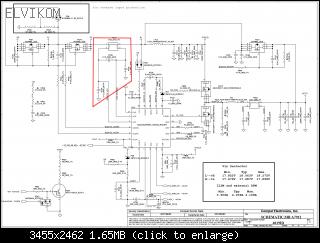Mam pytanie do doświadczonych kolegów.
Próbuję prześledzić przebieg ścieżki na płycie. Zdiagnozowałem zwarcie na płycie i wygląda na to, że zwarcie robi któryś z kondensatorów.
Na schemacie domyślam się który to, jednak na płycie ani kondensatory ani rezystory nie są oznaczone.
Próbuję prześledzić przebieg ścieżek po płycie i tu znowu brak mi doświadczenia jak czytać ścieżki na płycie.
Poniżej foto. Linią czerwoną i zieloną zaznaczyłem skąd dokąd uważam, że idą ścieżki od nogi 1 i 2 układu PU4. Domniemam, że kondensator do którego dochodzi zielona linia to PC30 (tylko którędy miałby się łączyć z PC26, Teraz myślę, że kawałek wyżej pod PU4). Jednak na przyszłość chętnie bym się dowiedział jak zidentyfikować dokąd idzie jego druga noga. Od kropki po obu stronach płyty nie ma żadnej ścieżki. Kondensator do którego idzie czerwona kreska to w/g mnie PC26. Pytanie jak stwierdzić który to i który to ten drugi (PC28 lub PC26). Czy jest jakaś prawidłowość w przelotkach ścieżek na drugą stronę płyty?
Jak zwykle wdzięczny będę za wszelkie porady.


Próbuję prześledzić przebieg ścieżki na płycie. Zdiagnozowałem zwarcie na płycie i wygląda na to, że zwarcie robi któryś z kondensatorów.
Na schemacie domyślam się który to, jednak na płycie ani kondensatory ani rezystory nie są oznaczone.
Próbuję prześledzić przebieg ścieżek po płycie i tu znowu brak mi doświadczenia jak czytać ścieżki na płycie.
Poniżej foto. Linią czerwoną i zieloną zaznaczyłem skąd dokąd uważam, że idą ścieżki od nogi 1 i 2 układu PU4. Domniemam, że kondensator do którego dochodzi zielona linia to PC30 (tylko którędy miałby się łączyć z PC26, Teraz myślę, że kawałek wyżej pod PU4). Jednak na przyszłość chętnie bym się dowiedział jak zidentyfikować dokąd idzie jego druga noga. Od kropki po obu stronach płyty nie ma żadnej ścieżki. Kondensator do którego idzie czerwona kreska to w/g mnie PC26. Pytanie jak stwierdzić który to i który to ten drugi (PC28 lub PC26). Czy jest jakaś prawidłowość w przelotkach ścieżek na drugą stronę płyty?
Jak zwykle wdzięczny będę za wszelkie porady.






